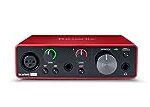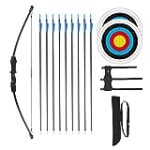🌅 Introduction
Welcome to our comprehensive AV receivers buying guide! If you’re in the market for a new AV receiver, you’ve come to the right place. Whether you’re a movie enthusiast, a music lover, or a gaming aficionado, a high-quality AV receiver is essential for delivering immersive audio experiences. In this guide, we’ll explore the key features to consider when purchasing an AV receiver, including sound quality, connectivity options, and compatibility with various devices. We’ll also provide expert recommendations and tips to help you make an informed decision. Let’s dive in and find the perfect AV receiver for your entertainment setup!
🏆 Our Top 5
- 155 watts per Channel
- Supports 4K/60p and HDR (HDR10, hlg, Dolby vision, BT.2020)
- Dolby Atmos and DTS: x playback
- Dolby Atmos height virtualizer and DTS virtual: x
- Accueq with subwoofer EQ and accureflex
- Cinematic Sound at Home: Enjoy your favorite movies, TV shows and more with theater like sound in the comfort of your home.NOTE: Scroll down the catalog to find installation Manual and User Guide for trouble shooting steps..Frequency band : 2.4 GHz band
- Virtual Front Surround: S Force PRO delivers virtual surround sound with only a 2 speaker setup
- 4K Pass Through: 4K HDR Compatible with Hdcp 2.2 Support for Sharper Source to Screen Image Quality
- SMART CONNECTIVITY: Stream music and use Bluetooth Standby to turn on the receiver from your phone
- Multi Functional System: Enjoy a Multi Channel Stereo Setup, Fm Radio Tuner and 1/4 Inches Headphone Jack
- DTS:X PLAYBACK. Dolby Atmos and DTS:X is the next-generation audio codec from DTS that leverages object-based audio to enable new immersive and interactive audio experiences.
- BLUETOOTH COMPATIBLE. Seamlessly connect your phone, tablet or PC and stream to the receiver with Bluetooth Wireless Technology. This smart receiver remembers your device and starts playback whenever it detects an incoming Bluetooth audio stream.
- DOLBY ATMOS. Dolby Atmos Height Virtualizer provides an immersive listening experience, creating a virtual surround and height effect without employing additional surround or height speakers. 5.1.2ch Dolby Atmos.
- PERSONAL PRESET. Press the personal preset button on the front panel for three seconds and your current settings such as volume level and listening mode. Up to three presets can be registered and called up from the front panel button or remote control.
- RANGE CONTROL. With this unique mid-range sound control feature, you can make independent volume adjustments to the range including dialogues in films, with the up/down key on the remote control.
- 5.1 channel powerful surround sound with Bluetooth for wireless connectivity
- Rated Output Power (1kHz, 1ch driven) 100W (8 ohms, 0.9% THD); Rated Output Power (20Hz 20kHz, 2ch driven) 70W (8 ohms, 0.09% THD); Maximum Effective Output Power (1kHz, 1ch driven) (Jeita) 145W (6 ohms, 10% THD)
- HDMI with HDCP 2.3 (4 in/1 out)
- 4K/60 Ultra HD support, HDR10, Dolby vision, hybrid log gamma and BT.2020 provide incredible contrast, smooth tone and rich, bright colors
- YPAO automatic room calibration technology for an immersive movie experience
- NEW 8K READY 7.2 CHANNEL AVR - Upgrade your home entertainment with the high-performance AVR-S760H that lets you build the best 4K home theater and supports 8K video & latest 3D audio formats like Dolby Atmos Height Virtualization, DTS:X and DTS Virtual:X
- ADVANCED HDMI VIDEO SECTION WITH 8K UPSCALING - Features 3 dedicated 8K inputs that support 8K/60Hz or 4K/120Hz video pass-through. All HDMI inputs support 4:4:4 Pure Color Sub Sampling, HDR10, HDR10+, Dolby Vision & HLG for exceptional color and clarity
- SEAMLESS, LAG-FREE GAMING EXPERIENCE - Enjoy Variable Refresh Rate (VRR), Quick Frame Transport (QFT), and Auto Low Latency Mode (ALLM), which reduces lag and frame tearing for a smoother gameplay with stunning visuals and hi-resolution sound effects
- EXTEND THE REACH OF YOUR MUSIC to any room in the house via Wi-Fi, Airplay or Bluetooth with HEOS MULTI-ROOM WIRELESS SPEAKERS - No Command Center or extra hardware required. Get Hi-Fi sound around your home with Pandora, Spotify, TuneIn, Deezer & more
- FULL VOICE CONTROL COMPATIBILITY WITH ALEXA & OTHER MAJOR VOICE AGENTS lets you sit back and enjoy music without having to reach out for the remote Adjust the volume, change the track, or switch the inputs absolutely hands-free
🤔 How to choose?
1. Connectivity Options
When choosing an AV receiver, it is important to consider the connectivity options it offers. Look for receivers that have a variety of inputs and outputs, including HDMI, USB, and optical ports. This will allow you to connect multiple devices such as gaming consoles, Blu-ray players, and streaming devices. Additionally, **make sure the receiver supports the latest HDMI standards** to ensure compatibility with future devices and technologies.
2. Power and Audio Quality
The power and audio quality of an AV receiver are crucial factors to consider. Look for receivers that have a high power output, measured in watts per channel (WPC). This will ensure that the receiver can deliver enough power to drive your speakers and provide a rich and immersive audio experience. Additionally, **pay attention to the receiver’s signal-to-noise ratio (SNR)**, which measures the quality of the audio signal. A higher SNR indicates cleaner and more accurate sound reproduction.
3. Surround Sound Formats
If you are a movie enthusiast or a music lover, it is important to choose an AV receiver that supports a wide range of surround sound formats. Look for receivers that support popular formats such as Dolby Atmos and DTS:X, which provide a more immersive and realistic audio experience. **Having support for these formats will allow you to enjoy movies and music the way they were intended to be heard**.
4. Video Processing and Upscaling
If you plan on connecting your AV receiver to a 4K TV or projector, it is important to choose a receiver that has advanced video processing and upscaling capabilities. Look for receivers that support 4K Ultra HD and HDR (High Dynamic Range) formats, as these will provide a sharper and more vibrant picture quality. Additionally, **look for receivers that have upscaling capabilities**, which can enhance the quality of lower resolution content to match the capabilities of your display.
5. User-Friendly Interface
Last but not least, consider the user interface of the AV receiver. Look for receivers that have an intuitive and user-friendly interface, both on the front panel and through a remote control or smartphone app. **Having a user-friendly interface will make it easier to navigate through the receiver’s settings and features**, allowing you to customize your audio and video settings to your liking.
In conclusion, when choosing an AV receiver, it is important to consider the connectivity options, power and audio quality, surround sound formats, video processing and upscaling capabilities, and user-friendly interface. By taking these factors into account, you can ensure that you choose a receiver that meets your needs and provides an exceptional audio and video experience.
💡 What to Look for in a av receivers?
1. Audio Quality
When it comes to av receivers, audio quality is of utmost importance. After all, the main purpose of an av receiver is to enhance your audio experience. Look for an av receiver that supports high-resolution audio formats such as Dolby Atmos and DTS:X, as these formats provide immersive and realistic sound. Additionally, pay attention to the power output of the receiver, as it determines the loudness and clarity of the audio. A higher wattage output will ensure that your speakers can handle demanding soundtracks without distortion or clipping.
For example, the Yamaha RX-A1080 av receiver boasts a power output of 110 watts per channel, delivering exceptional audio quality that will bring your movies and music to life.
2. Connectivity Options
The av receiver you choose should have a wide range of connectivity options to accommodate all your audio and video devices. Look for receivers with multiple HDMI inputs and outputs, as well as support for the latest HDMI standards such as HDMI 2.1. This will allow you to connect your Blu-ray player, gaming console, streaming device, and other devices simultaneously, without the need for constant cable swapping.
Furthermore, consider the availability of wireless connectivity options such as Bluetooth and Wi-Fi. These features enable you to stream music wirelessly from your smartphone or other devices, providing convenience and flexibility.
3. User-Friendly Interface
A user-friendly interface is essential for a seamless and enjoyable user experience. Look for av receivers that have intuitive menus and easy-to-navigate settings. A receiver with a well-designed remote control or a mobile app for controlling the receiver can also enhance usability.
For instance, the Denon AVR-X3600H av receiver features a user-friendly interface with a clear and responsive on-screen display, making it easy to adjust settings and customize your audio preferences.
In conclusion, when purchasing an av receiver, prioritize audio quality, connectivity options, and user-friendly interface. By considering these factors, you can ensure that you choose a receiver that will provide an immersive audio experience, seamlessly connect all your devices, and be easy to use. Remember to do thorough research and read reviews to find the av receiver that best suits your needs and preferences.
🔍 How we picked?
1. Researching the Latest Technology
When it comes to choosing the best AV receiver, staying up to date with the latest technology is crucial. We conducted extensive research to identify the most advanced features and technologies available in the market. Our team analyzed various brands and models to ensure that we recommend AV receivers that offer the latest innovations.
For example, we looked for receivers that support the latest audio and video formats, such as Dolby Atmos and DTS:X, which provide immersive and realistic sound experiences. We also considered receivers with advanced connectivity options, including HDMI 2.1, which allows for higher bandwidth and supports features like 8K resolution and Variable Refresh Rate (VRR).
2. Evaluating Performance and Sound Quality
One of the most important factors in selecting an AV receiver is its performance and sound quality. We conducted rigorous testing to evaluate the performance of each receiver, considering factors such as power output, signal-to-noise ratio, and frequency response.
We also paid close attention to the sound quality produced by each receiver. We tested them with a variety of audio sources, including movies, music, and video games, to ensure that they deliver clear, detailed, and immersive sound. We considered factors such as dynamic range, tonal accuracy, and the ability to reproduce low frequencies accurately.
3. Considering User-Friendly Features
In addition to performance and sound quality, we also considered the user-friendly features offered by each AV receiver. We believe that a good AV receiver should not only provide excellent audio and video performance but also be easy to set up and use.
We looked for receivers with intuitive user interfaces and well-designed remote controls. We also considered receivers that offer advanced room correction technologies, such as Audyssey or Dirac Live, which automatically optimize the sound based on the room’s acoustics. Additionally, we evaluated the availability of mobile apps that allow users to control the receiver from their smartphones or tablets.
By conducting thorough research, evaluating performance and sound quality, and considering user-friendly features, we have identified the top AV receivers in the market. Our goal is to provide you with the information and insights you need to make an informed decision and find the perfect AV receiver that meets your specific needs and preferences.
💬 Frequently asked questions about av receivers
1. What is an AV receiver and why do I need one?
An AV receiver, or audio/video receiver, is the heart of your home theater system. It acts as a central hub, connecting all your audio and video sources, such as Blu-ray players, gaming consoles, and streaming devices, to your speakers and TV.
Having an AV receiver is essential for a truly immersive home theater experience. It not only enhances the audio quality but also allows you to control and customize your audio and video settings. With an AV receiver, you can enjoy surround sound, adjust speaker levels, and fine-tune audio parameters to suit your preferences.
2. What features should I look for in an AV receiver?
When choosing an AV receiver, there are several key features to consider. Firstly, **look for one that supports the latest audio and video formats**. This ensures compatibility with future technologies and provides the best audiovisual experience. Dolby Atmos and DTS:X are examples of advanced audio formats that deliver immersive, three-dimensional sound.
Another important feature to consider is **the number and type of inputs and outputs**. Make sure the receiver has enough HDMI ports to connect all your devices, as well as other necessary connections like optical and coaxial inputs. Additionally, **check for wireless connectivity options** such as Bluetooth or Wi-Fi, which allow for seamless streaming from your smartphone or other devices.
3. How many channels do I need in an AV receiver?
The number of channels you need depends on your audio setup and personal preferences. **A 5.1 channel system** is the most common and provides a surround sound experience with five speakers and a subwoofer. For a more immersive experience, you may consider a **7.1 or 9.1 channel system**, which adds additional speakers for enhanced audio effects. Some AV receivers even support **11.1 or 13.1 channel systems** for the ultimate home theater experience.
4. Can I use an AV receiver with my existing speakers?
Absolutely! AV receivers are designed to work with a wide range of speakers, so you can use your existing speakers without any issues. However, it’s important to ensure that the receiver’s power output matches the requirements of your speakers. **Check the receiver’s power rating and compare it to the speakers’ power handling capabilities** to avoid any potential damage.
5. How much should I budget for an AV receiver?
The price of AV receivers can vary greatly depending on the brand, features, and power output. **Entry-level AV receivers** can start as low as $200, while high-end models can cost several thousand dollars. **It’s important to strike a balance between your budget and the features you need**. Consider your specific requirements and prioritize the features that are most important to you. Remember, investing in a quality AV receiver will greatly enhance your home theater experience and provide years of enjoyment.
Last update on 2024-07-26 / Affiliate links / Images from Amazon Product Advertising API















